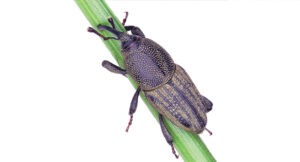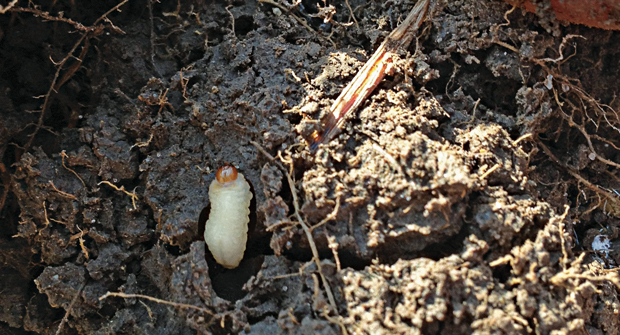After a January Arctic air mass plunged most of the central, eastern and even southern U.S. into a frozen winter wasteland, many lawn care operators (LCOs) are relieved to see the weather warm back up in preparation for spring.
However, as winter begins to close, preparations for the inevitable springtime turf pests are open for business.
One such pest that can plague the northern to central U.S., even stretching west into Idaho and Utah, is the bluegrass billbug (Sphenophorus parvulus). Shannon Slevin, Quali-Pro’s northeast territory manager, says these pests are small — roughly a quarter of an inch — and rigid insects with a distinctively curved snout at the front. They’re usually black or grey with long grooves running down their back.

Slevin says the bugs like to overwinter in some type of coverage or leaf litter on the outskirts of properties, and when the soil starts warming in the spring (roughly late April to early May), the adults emerge and traverse the property to feed and mate.
“The preferred turf is Kentucky bluegrass,” Slevin says. “They will chomp on perennial rye and fescues as well, but it’s normally Kentucky bluegrass.”
Feeding frenzy
During the initial feeding, Slevin says there’s usually little damage; it’s the upcoming generations that become an issue.
After the billbugs emerge, feed and mate, female billbugs can lay more than 200 eggs. When these eggs become larvae, Slevin says they chomp on the roots and crowns of the plant, causing significant damage to the turf usually around late June.

Sometimes, the new adults can even repeat the process in the same year, meaning another wave of eggs and larvae could wreak more havoc on lawns later into the summer.
“There’s typically two generations within 30 day cycles, so that second generation damage you would see mid- to late-July,” Slevin says.
Slevin warns that with billbug feedings cause turf to look wilty and yellowed, and one of the biggest mistakes LCOs can make is misidentifying it as drought damage if left untreated.
“If it’s completely overlooked, you may confuse some of the untreated damage from the insect with turf drought,” Slevin says. “I think that could be one of the key driving things that you need to start scouting well into that late June period if it’s left untreated for the first generation.”
Beat the bug
Once billbugs are identified, treating them can be fairly straightforward. Slevin, for example, says the active ingredient chlorantraniliprole historically has been very effective.
“(Chlorantraniliprole) has done really well in the past with Acelepryn,” Slevin says. “There’s a lot of other manufacturers that have access to that molecule currently, and Quali-Pro will be one of those manufacturers here in the very near future with that molecule as a control option as well.”
Slevin also says Quali-Pro also offers a new chemistry called Suprado to help fight against billbugs and other turf pests.
“It is an insect growth regulator,” he says. “It covers the complete life cycle from eggs to larvae to adults, controlling each phase as it molts.”
In addition to choosing the right chemical to eliminate billbugs, Slevin says LCOs that are doing aerification and interseeding can also choose the right grass to resist the issue in the first place.
“I would suggest that those folks look out for turf varieties of Kentucky bluegrass that’s actually bred and designed to be billbug resistant,” Slevin says. “There’s a lot of new varieties out there on the market that are actually bred for that purpose.”


